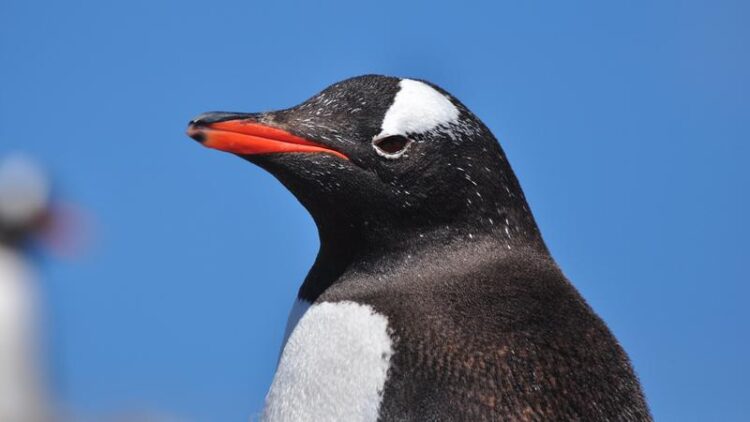Climate change puts penguins on the move

Gentoo penguin, photographed in the Jena researchers' study area on King George Island. As a result of climate change, this species is spreading in the Antarctic.
Photo: Christina Braun
For decades, a research team from the University of Jena has travelled regularly to the Antarctic. Its most recent observations of Antarctic wildlife paint a clear picture of climate change in the southernmost part of the world.
If there were ever a prize for the longest journey to work, the Jena University team led by Christina Braun would stand a good chance of winning it. To reach their research area, the polar ornithologist and her team travel some 14,000 kilometres – as the crow flies – each time. Their destination is the Fildes Peninsula on King George Island in the Antarctic.
Researchers from the University of Jena have been observing changes in the Antarctic fauna since the early 1980s. Since 2003, their long-term monitoring project, studying breeding birds and seals, has been funded by the German Environment Agency. A few weeks ago, Christina Braun, Hannes Grämer and the students Noëlle Heid and Nora Förster returned to Jena from their latest stay in the Antarctic, and they have now carried out the first analyses of their research data.
During their three-month-long Antarctic trips, the researchers document the occurrence of a total of 14 breeding bird species in a defined area of around 35 km2. These include penguin species, such as the chinstrap, Adélie and gentoo penguins, as well as skuas and giant petrels. “We count the number of breeding pairs and their breeding success, that is to say how many chicks have survived at the end of the season,” says Christina Braun. She has been part of Jena University’s Polar and Bird Ecology working group since 2000 and this year marked her 14th research visit to Antarctica. “This monitoring, over what is now a period of four decades, is unprecedented and our data are an important basis for research”, she notes.
Climate change alters species ratio
The researchers can read clear trends from their observations. For example, cape petrels, which once bred in their hundreds in the research area, have almost completely disappeared. The researchers from Jena only discovered three breeding pairs during this year’s stay. Other species are significantly increasing in numbers, including the giant petrel. “This is due to changing environmental conditions, particularly as a result of climate change,” says Christina Braun. Giant petrels benefit from the warming of the ocean, where they find a more abundant food supply. The researchers also observed similar shifts by penguins. While gentoo penguins, which are originally from sub-Antarctic regions, are spreading ever further, species typical of Antarctica, such as Adélie and chinstrap penguins, are in retreat. “Both species depend on sea ice, as it forms the basis of the Antarctic food chain, with Antarctic krill, the main food source for penguins and whales, grazing on the ice algae that are available there. As the sea ice continues to shrink, the penguins are migrating ever further south, to less suitable areas,” says Braun.
Together with Uruguayan colleagues, the researchers from Jena have also been involved in monitoring the breeding success of gentoo penguins throughout the Antarctic. “We’ve observed how the animals grow and gain weight,” explains research assistant Hannes Grämer, a member of the Jena expedition team. In practice, this meant catching and weighing 20 young animals every day. While gentoo penguin chicks weigh around 110 grams when they hatch, they reach between 3.5 and 6 kilos at the end of the summer. “Their weight ultimately determines their chances of survival in the winter ahead,” says Grämer, who was on his fourth expedition to the Antarctic.
In the coming months, the researchers will process the data collected during the past season for a new edition of the report entitled “Monitoring der klimabedingten Veränderungen terrestrischer und mariner Ökosysteme in der Maxwell Bay (Antarktis)” (Monitoring climate-induced changes in terrestrial and marine ecosystems in Maxwell Bay (Antarctica)), which the Federal Environment Agency publishes every three years. The results will also be published in scientific journals. And after that, it will soon be time to plan the next trip. In November, or December at the latest, the team from Jena will set off again to observe the changes in the Antarctic fauna.
Contact for scientific information:
Christina Braun
Institute of Ecology and Evolution of Friedrich Schiller University Jena
Dornburger Straße 159, 07743 Jena, Germany
Tel.: +49 (0)3641 9-49445
E-mail: chr.braun@uni-jena.de
Media Contact
All latest news from the category: Ecology, The Environment and Conservation
This complex theme deals primarily with interactions between organisms and the environmental factors that impact them, but to a greater extent between individual inanimate environmental factors.
innovations-report offers informative reports and articles on topics such as climate protection, landscape conservation, ecological systems, wildlife and nature parks and ecosystem efficiency and balance.
Newest articles

NTU and NUS spin-off cutting-edge quantum control technology
AQSolotl’s quantum controller is designed to be adaptable, scalable and cost-efficient. Quantum technology jointly developed at Nanyang Technological University, Singapore (NTU Singapore) and National University of Singapore (NUS) has now…

How Geothermal Energy Shapes Bavaria’s Green Future Through Sustainable Energy
The Bavarian State Ministry of Science and the Arts has extended its funding for the research association “Geothermal Alliance Bavaria,” with the University of Bayreuth (UBT) continuing as a member…

Spintronics memory innovation: A new perpendicular magnetized film
Long gone are the days where all our data could fit on a two-megabyte floppy disk. In today’s information-based society, the increasing volume of information being handled demands that we…



